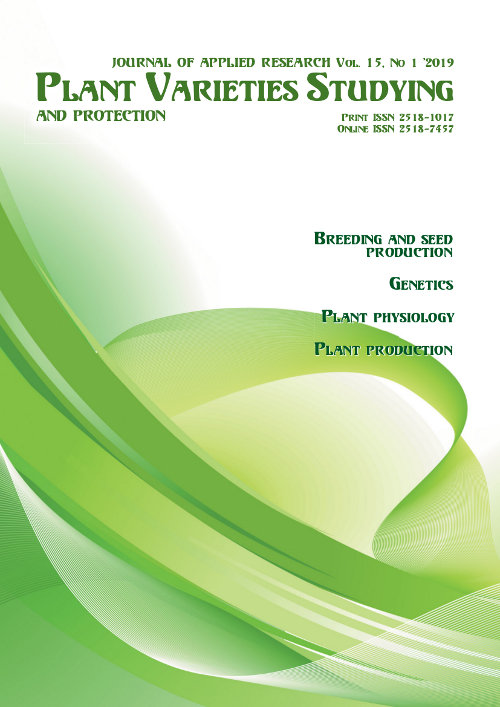Estimation of the source material for breeding of self-fertile varieties of alfalfa with high seed yield
DOI:
https://doi.org/10.21498/2518-1017.15.1.2019.162475Keywords:
Medicago sativa L., autogamy level, self-pollination, pollen fertility, pod-set, seed productivityAbstract
Purpose. Obtaining the highly self-fertile samples of alfalfa with a minimal effect of inbreeding depression on seed productivity for the use in the further selective breeding.
Methods. Field, laboratory, mathematical and statistical.
Results. The expansion of the area under valuable high-protein perennial crops of alfalfa is limited by the lack of seeds due to the low yield of its modern varieties. In conditions of insufficient numbers of pollinating insects, cross-breeding varieties have low seed yield. Thus, self-fertile varieties may have an increased seed yield, since their plants are able to form seeds by self-pollination. As a result of studying 58 samples of the breeding nursery of alfalfa, among which there were inbred lines of 8–10 generations and hybrids, a high level of their self-fertility was determined. Pollen fertility of most samples ranged from 78.6 to 96.5%, and only eight of them showed a decrease to 63.6–78.0%. Selections for the components of seed productivity allowed us to distinguish samples with the number of flowers in the inflorescence from 22.0 to 36.2 pcs. (standard variety ‘Yaroslavna’ – 26.9 pcs.); with the number of set pods from free pollination – from 13.0 up to 21.0 pcs. (standard variety – 16.5 pcs.). The seed yield varied from 10.17 to 35.63 g/m2, and in the standard variety it was 22.03 g/m2. Conclusions. The level of self-fertility of the studied samples of the breeding nursery of alfalfa was quite high – from 32.6 to 68.1%. This breeding material was obtained from the previously created autogamous forms and selected in terms of the minimum effect of inbreeding depression on seed yield. All the obtained breeding material, among which there are hybrids between highly self-fertile samples and inbred lines, will later be used in the selection process to create alfalfa varieties with high seed yield.
Downloads
References
Russelle, M. P. (2001). Alfalfa: After an 8,000-year journey, the “Queen of Forages” stands poised to enjoy renewed popularity. Am. Sci., 89(3), 252–261. doi: 10.1511/2001.3.252
Tkachenko, I. K., Dumacheva, E. V., Babenkov, V. L., & Voronkina, T. I. (2008). Problems and the tasks of autogamy in lucerne. Naučnye vedomosti Belgorodskogo gosudarstvennogo universiteta. Estestvennye nauki [Belgorod State University Scientific Bulletin. Natural Sciences], 3(6), 60–68. [in Russian]
Bober, A. F., & Bashkirova, N. V. (1999). Breeding of varieties of autogamous alfalfa for the conditions of Ukraine. Zbirnyk naukovykh prats NNTs “Instytut zemlerobstva UAAN” [Scientific magazine NSC “Institute of Agriculture UAAS”], 3, 36–39. [in Ukrainian]
Riday, H., Reisen Р., Raasch, J. A., Santa-Martinez, E., & Brunet, J. (2015). Selfing rate in an alfalfa seed production field pollinated with leafcutter bees. Crop Sci., 55(3), 1087–1095. doi: 10.2135/cropsci2014.04.0295
Turganova, T. A., & Nurgaliev, N. Sh. (2014). Fertility and self-fertility studies in different ecotypes of blue alfalfa (M. sativa L.). Molodoj učenyj [Young Scientist], 1.2, 34–37. [in Russian]
Shumny, V. K. (2004). Problems of plant genetics. Vestnik VOGiS [VOGiS Herald], 8(2), 32–39. [in Russian]
Dospekhov, B. A. (1985). Metodika polevogo opyta (s osnovami statisticheskoy obrabotki rezul´tatov issledovaniy) [Methods of field experiment (with the basics of statistical processing of research results)]. (5nd ed., rev.). Moscow: Agropromizdat. [in Russian]
Meyrman, G. T. (1991). Seed productivity of experimental alfalfa populations depending on the level of inbreeding and self-fertility of the original clones. Vestnik Sel’skokhozyaystvennoy Nauki [Вulletin of Agricultural Science], 7, 34–42. [in Russian]
Loginov, Yu. P., Dyukova, N. N., & Shadrina, N. V. (2013). Substantiation of alfalfa variety model parameters for the North Trans-Urals’ conditions. Agrar. Vestn. Urala [Agrarian Bulletin of the Urals], 9, 9–12. [in Russian]
Downloads
Published
How to Cite
Issue
Section
License
Copyright (c) 2019 Н. В. Башкірова, Н. В. Курочка

This work is licensed under a Creative Commons Attribution-ShareAlike 4.0 International License.
Our journal abides by the CREATIVE COMMONS copyright rights and permissions for open access journals.
Authors, who are published in this journal, agree to the following conditions:
1. The authors reserve the right to authorship of the work and pass the first publication right of this work to the journal under the terms of a Creative Commons Attribution License, which allows others to freely distribute the published research with the obligatory reference to the authors of the original work and the first publication of the work in this journal.
2. The authors have the right to conclude separate supplement agreements that relate to non-exclusive work distribution in the form in which it has been published by the journal (for example, to upload the work to the online storage of the journal or publish it as part of a monograph), provided that the reference to the first publication of the work in this journal is included.


























 Ukrainian Institute for Plant Varieties Examination
Ukrainian Institute for Plant Varieties Examination  Селекційно-генетичний інститут
Селекційно-генетичний інститут Institute of Plant Physiology and Genetics of the National Academy of Sciences of Ukraine
Institute of Plant Physiology and Genetics of the National Academy of Sciences of Ukraine
 The National Academy of Agrarian Sciences of Ukraine
The National Academy of Agrarian Sciences of Ukraine